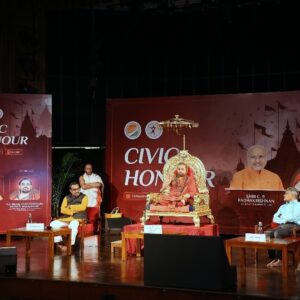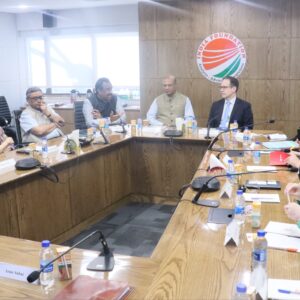The Association of South East Asian Nations (ASEAN) celebrates 50 years of its existence this year. At the same time, India and ASEAN are commemorating the 25th Anniversary of their Dialogue Relations by organising a wide range of international events – conferences, business conclaves, youth and cultural festivals, such as the India-ASEAN Connectivity Summit, India-ASEAN Youth Summit 2017 held in Bhopal, car rallies, etc. The year 2017 also marks 15 years of summit sevel relation and five years of strategic partnership between India and ASEAN. Since 2002, the India-ASEAN Summit has become an annual affair. In the 13th summit held in Kuala Lumpur on 21 November 2015, the ASEAN leaders acknowledged that India’s “Make in India” and “Act East Policy” initiatives could reinforce ASEAN’s community building efforts. The grouping’s leaders also expect India to work with ASEAN to achieve the goals reflected in the ASEAN 2025: “Forging Ahead Together”. In the Post Ministerial Conference (PMC) Plus One Session with India, held on 5 August 2015 in Kuala Lumpur, the ASEAN and Indian leaders adopted the Plan of Action (POA) to implement the ASEAN-India Partnership for Peace, Progress and Shared Prosperity (2016-2020) comprising three broad areas of cooperation: “political and security cooperation; economic cooperation; and socio-cultural cooperation”.
At a time when global economic growth has been sluggish and there are growing uncertainties due to conflicts in other parts of the world, ASEAN has consolidated itself into a common economic community and become the most dynamic region in the world. The ASEAN way of decision making by consensus has enhanced its unity as well as centrality in the Asia-Pacific region. India can learn immensely from the ASEAN experience, its economic integration in particular. The Indian Prime Minister has rightly placed South East Asia at the core of India’s Act East Policy – a significant foreign policy initiative to deepen India’s comprehensive engagement and strategic partnership with ASEAN. Both India and ASEAN could enjoy mutual benefits out of such partnerships, and together, they can contribute to regional growth and stability. In the last two years, Indian President, Vice President and Prime Minister had visited nine out of 10 ASEAN countries. The Prime Minister was present at three ASEAN-India and East Asia Summits held in 2014, 2015 and 2016, and he had visited five ASEAN countries, viz., Myanmar, Singapore, Malaysia, Laos and Vietnam, and also 11 East Asia Summit associated countries, including the United States (US), Russia, Australia, China, Japan, Vietnam and Laos. India has set up a mission to ASEAN and the East Asia Summit (EAS) in Jakarta with a dedicated ambassador to ensure a smooth functioning. All this bears testimony to the importance India attaches to its relationship with ASEAN.
India’s endeavour to strengthen its relations with ASEAN comes at this crucial juncture when China becomes more assertive in the region. Beijing’s territorial claims in the oil and gas-rich South-China Sea, which is also a vital international maritime trade route, have caused serious regional security concern. Both India and ASEAN, indeed, keep the China factor in mind and act accordingly in order to sustain a stable balance of power in South East Asia. As natural allies, they participate in the EAS, ASEAN Regional Forum (ARF), ASEAN Defence Ministers Meeting Plus (ADMM+), and the Expanded ASEAN Maritime Forum (EAMF).1 TheADMM + provides a forum for defence ministers from the 10 nations of ASEAN plus India, China, Japan, Republic of Korea, Russia, Australia, New Zealand, and the US on a biannual basis. The EAMF creates avenue for diplomacy focussing on maritime issues of common concern.2 The ASEAN is keen to work together with India in securing trade routes and freedom of navigation in international waters and over flights, reducing piracy along the Malacca Straits, addressing traditional and non-traditional security challenges, including ‘de-radicalisation, prevention of violent extremism and cyber crime’. In the new regional security configuration, ASEAN and India also need to focus on the prospects of tackling threats like poverty, transnational health threats, environmental degradation, natural disasters and transnational crimes.3 Most states in the region expect India to be a serious player in the Indo-Pacific. For that, India needs to give the signal that it is committed to a long- term strategic presence in the region.4For both India and ASEAN, connectivity is a matter of strategic priority. At the 13th ASEAN-India Summit held in Malaysia in November 2015, Prime Minister Modi announced a Line of Credit of USD 1 billion for projects that support physical and digital connectivity between India and ASEAN and a Project Development Fund with a corpus of INR 500 crore to develop manufacturing hubs in Cambodia, Laos, Myanmar, Vietnam (CLMV) countries. India supports the Master Plan on ASEAN Plus Connectivity (MPAC) and backs the extension of India-Myanmar-Thailand Trilateral Highway to Laos, Cambodia and Vietnam, and its further linkage with ports in ASEAN countries and integration with Special Economic Zones. Enhanced connectivity to ASEAN region can significantly factor in unlocking the economic energies and enterprise of India’s Northeast, which borders the region. In short, “Connectivity is the reigning mantra as India deepens its diplomatic, economic and cultural ties with its extended neighbourhood”.5
As India and ASEAN share deep economic ties, their trade and investment relations have grown over time. Their annual trade stood at USD 76.63 billion in 2015, although it declined to USD 65.04 billion in 2015-16 due to the slowing down of the global economy. India is ASEAN’s 7th largest trade partner, and ASEAN is India’s 4th largest trading partner which accounts for 10.02 per cent of India’s total trade. Investment flows have also increased. “FDI flows into India from ASEAN between April 2000 to May 2016 was about USD 49.40 billion, while FDI outflows from India to ASEAN countries, from April 2007 to March 2015, as per data maintained by DEA, was about USD 38.672 billion”.6 The ASEAN-India Free Trade Area has been completed with the enforcement of the ASEAN-India Agreements on Trade in Service and Investments on 1st July 2015. The agreement affirms India’s adherence to the vision of having greater economic engagement with ASEAN. India’s service-oriented economy should also complement the manufacturing–based economies of ASEAN. India is also engaged in the Regional Comprehensive Economic Partnership (RCEP) negotiations with ASEAN and its 6 FTA partners. India and ASEAN have also been working on enhancing engagement in private sector, particularly with an objective to bring key private players on a single platform such as ASEAN-India Business Council.
India offers project-based assistance to ASEAN countries from various Funds created under ASEAN Multilateral Division. At the ASEAN-India Summit (2009), India announced USD 50 million contribution to the ASEAN-India Fund for implementation of the ASEAN-India Plan of Action. At the 6th ASEAN-India Summit held in Singapore (2007), India announced the setting up of an ASEAN-India Science & Technology Development Fund (AISTDF) with a contribution of USD 1 million and ASEAN-India Green Fund with a contribution of USD 5 million for collaboration activities relating to environment and climate change. Besides, India has been associating with ASEAN in the implementation of projects in the fields of Agriculture, Science and Technology, Peace, Human Resource Development, Capacity Building, New and Renewable Energy, Tourism, People-to-People contacts, etc.7
Tolerance, pluralism and diversity preserved, maintained and practiced by India and the ASEAN countries can be a unique example for the rest of the world. These salient characteristic can further strengthen the ties between the two.8 India has accorded priority to promoting its soft power in Southeast Asia “through a vigorous engagement with the diaspora and a strong commitment to build a shared civilisational bonds” – renewing spiritual connectivity with Asia which is as important as physical connectivity.9 Indeed, the large Indian diaspora in the Southeast Asian countries helps strengthen diplomatic, economic and security relations between India and ASEAN. In the presence of such driving forces, it is imperative for both to put in extra efforts to materialise the vision of an ‘Asian century’ that is becoming real with the increasing “shift of economic gravity from the north to the south and the west to the east”.
The Asian dream, therefore, is about surging hopes and aspirations of 1.8 billion people of India and Southeast Asia, who are inching towards carving their place in the changing world. India should seize the moment to chart the course of its strategic partnership with the ASEAN countries and convince them that “India is both a factor for peace and stability in Asia as well as a partner in progress”.10 India and ASEAN stands as natural partners further contributing in the progress of the wider Indo-Pacific region.
References:-
1 Pant, Harsh V., Avantika Deb: “India and The ASEAN At 25: Celebrating The Past, Preparing For The Future”, July 04, 2017, ORF Issue Brief. Accessed 20th August, 2017. http://www.orfonline.org/research/india-asean-partnership-at-25/.
2 ASEAN Progress & Prosperity, March 2, 2017: “ASEAN- India Relations”. Accessed 20th August, 2017. http://www.mea.gov.in/aseanindia/20-years.htm.
3 “India ASEAN – A 25 Year long Journey”, February 25, 2017.Accessed 21st August, 2017. http://raja sacademy.com.com/.
4 Roche, Elizabeth. “Why 2017 is a landmark year for India, ASEAN Ties”. Live Mint, February 7, 2017. Accessed August 21, 2017. www.livemint.com/Politics/zahCdddqQwMjQC7X5ykoyO/Why-2017-is-a-landmark-year-for-India-ASEAN-ties.html.
5 Chand, Manish. “India’s Enhanced Look East Policy takes wing”. Ministry of External Affairs, Govt. of India, August 7, 2014. Accessed August 21, 2017.www.mea.gov.in/in-focusarticle.htm?23855/Indias+Enhanced +Look+East+policy+takes+wing.
6 ASEAN Progress & Prosperity, March 2, 2017: “ASEAN- India Relations”. Accessed 20th August, 2017. http://www.mea.gov.in/aseanindia/20-years.htm.
7 Ibid.
8 Saran, Preeti. “India and ASEAN- An Overview”. Speech, New Delhi, February 2, 2017. Nehru Memorial Museum and Library. www.mea.gov.in/aseanindia/Speeches-Statements.htm?dtl/22615/Keynote+ Address+by+Secretary+East+on+India+and+ASEAN++An+Overview+at+Nehru+Memorial+Museum+ and+Library+New+Delhi+February+2+2017.
9 Raja Mohan, C. “From Looking East to Acting East”. Ministry of External Affairs, Govt. of India, January 29, 2015. Accessed August 22, 2017.
10 Baru, Sanjaya “India and ASEAN: The Emerging Economic Relationship Towards a Bay of Bengal Community.” February, 2001, India Council For Research on International Economic Relations, New Delhi.
(Dr. Shristi Pukhrem is a Senior Research Fellow at India Foundation.)
(This article is carried in the print edition of January-February 2018 issue of India Foundation Journal.)



